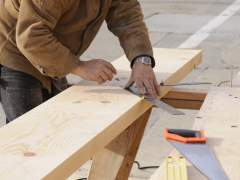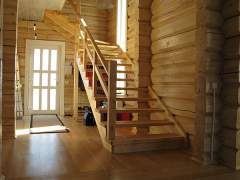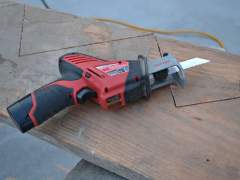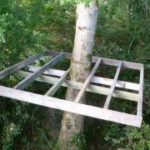What are stair stringers, their functions and specifications. Recommendations on how to cut stair stringers properly in order to make a secure structure.
 Stair stringers stand for the backbone intended to bear load of your staircase. It is desirable to know how to cut stair stringers if you’ve made up your mind to install stairs for your porch, deck or interior of a multi-storey house. Stair stringers support the stairs’ structure. The staircase built on stair stringers is a classic case. These designs have a high level of strength and are characterized by refined and respectable look.
Stair stringers stand for the backbone intended to bear load of your staircase. It is desirable to know how to cut stair stringers if you’ve made up your mind to install stairs for your porch, deck or interior of a multi-storey house. Stair stringers support the stairs’ structure. The staircase built on stair stringers is a classic case. These designs have a high level of strength and are characterized by refined and respectable look.
There are stair stringers that have risers or not. If it is an open staircase, which has no risers, it is quite a lightweight design. Otherwise, the structure looks massive, but it is more reliable. People won’t be afraid of stumbling and their leg falling between the two steps, which could lead to injury. As for the price of a solid staircase, it will be higher.
How to make stair stringers at home: step-by-step instruction
 For stair stringers it is advisable to use a formula of 2×12 straight high quality wood that is pressure treated. The wood should correspond 60 RET level in case you are going to rest the stair stringer onto the ground.
For stair stringers it is advisable to use a formula of 2×12 straight high quality wood that is pressure treated. The wood should correspond 60 RET level in case you are going to rest the stair stringer onto the ground.
First you need to prepare the workpiece for the stringers. To do that, lay out the first 2×12 board on saw horses and take clamps and a framing square to draw the contour of the stair. Clamp wooden rule or a straight stick to the steel square using clamps in accordance with the dimensions of your stairs’ run and rise.
Carry out lining the height of a riser and depth of the tread on a framing square and aligning it to the stringer. Thus you will define the exact angle of cutting your stairs. Trace the square to point the dimensions of first run and rise, and then move the square along the edge of your workpiece to make the next set.
Repeat this procedure along the whole stringer. Since the bottom step is going to be placed on the ground you’ll see  that it is too short comparing to the height of the tread. After each stringer has been traced you need to perform an adjustment. Further, drop the stringer by having cut off the depth of one tread in order to adjust the design for placing on the ground. This cut allows reducing the thickness of treads in your stringer so that the first stair wouldn’t get higher when adding its tread. An additional adjustment of the upper step may be required if you make some inaccuracies when attaching the stringer. It is necessary to create an even stair design.
that it is too short comparing to the height of the tread. After each stringer has been traced you need to perform an adjustment. Further, drop the stringer by having cut off the depth of one tread in order to adjust the design for placing on the ground. This cut allows reducing the thickness of treads in your stringer so that the first stair wouldn’t get higher when adding its tread. An additional adjustment of the upper step may be required if you make some inaccuracies when attaching the stringer. It is necessary to create an even stair design.
If you’re intended to attach riser boards (they are meant to close off front side of the steps, thus the area below the steps can’t be seen), it is necessary to define if the thickness of riser boards should be compensated by lengthening the top most run. The width of the top steps is likely to be consumed by the upper riser board. This depends on if the area of stringer mounting is already faced or whether you’re going to add a stringer board there too.
How to build stair stringers properly
 There are several methods stair stringers are typically attached. The easiest way is to use the square for outlining the first stringer. Next, the cutting is performed and the square is traced for all the remaining stair stringers. This will ensure cutting all the stringers of the same length, which is always very easy as you just keep sliding the square alongside the workpiece.
There are several methods stair stringers are typically attached. The easiest way is to use the square for outlining the first stringer. Next, the cutting is performed and the square is traced for all the remaining stair stringers. This will ensure cutting all the stringers of the same length, which is always very easy as you just keep sliding the square alongside the workpiece.
In the case the top step is impossible to level with the landing, you better make the string longer so that it could pass behind the front board to the appropriate mounting position. According to this method the face board is usually notched. This allows the stringer for passing through. This method of mounting the stair stringer presupposes making a longer stringer and weakens the front board a bit.
If you’re likely to apply this arrangement in mounting stringers, it will be necessary to cut the uppermost run of stringers a little bit longer where it interferes with the front board. This doesn’t typically weaken the stair stringer significantly, but be careful as you are actually thinning the stringer a little when you cut deeper through it. The dimension of a run is necessary to remain unaltered as well as the others although the run still passes through under the front board.
The most preferred method of building stair stringers is the one described below. The front board along with the stringer isn’t cut any more than it is required. The only actual disadvantage here is the upper stair tread that is flushed with the deck resulting in the staircase being one tread longer in its full length. When resorting to this method of cutting stringers you actually obtain the same quantity of rises as runs. Other two types of stringers possess one less run than rise.
Cutting the stringers
Perform the cuts using a circular saw but do not overcut the guidelines. This won’t look good and can weaken the stringer. For finishing the cut cleanly it is better to use a handsaw. As soon as cutting one stringer has been accomplished and checked up for accuracy you can just apply it as a template when producing the others.
Complete the cutting of other stair stringers. Use a handsaw or a jigsaw for the purpose. Adhere to the drawing lines and try not to overcut



